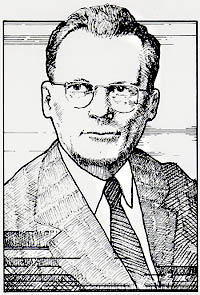Richard P Moore (1896-1987)
Moore was born on a Connecticut farm and stopped school after the eighth grade to work full time for his father, a surveyor. In 1915 he went to Bridgeport and worked for Remington in the milling department and then the toolroom, next for various job shops and in the toolroom at Singer. During this period he went to night school to complete his education, then set up his own shop which soon became noted for handling the difficult, precise jobs. Jig borers, at the time, used end masures or unhardened leadscrews compensated for using hardened and ground leadscrews, in 1932. This machine and its successors eventually gained worldwide recognition. Next came the invention of the jig grinder, which extended accurate hole location to hardened work. This machine has essentially the base, table, and column of a jig borer, with a grinding head that reciprocates over an adjustable distance, carries a small grinding wheel through an orbital path, and can be set at an angle to grind tapers. Then came the universal measuring machine and a succession of measuring instruments. Moore is credited with giving metalworking plants an additional decimal point of accuracy.
Elected 1988


 Machine Tool Builder
Machine Tool Builder
 Inventor
Inventor